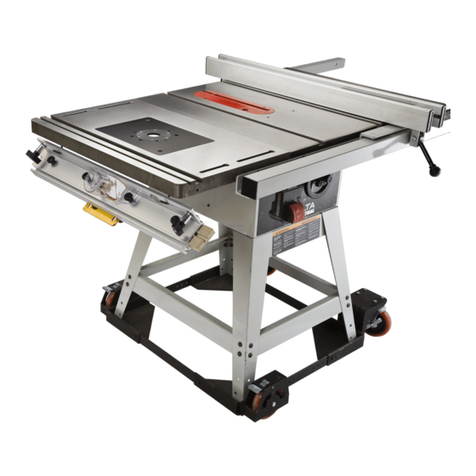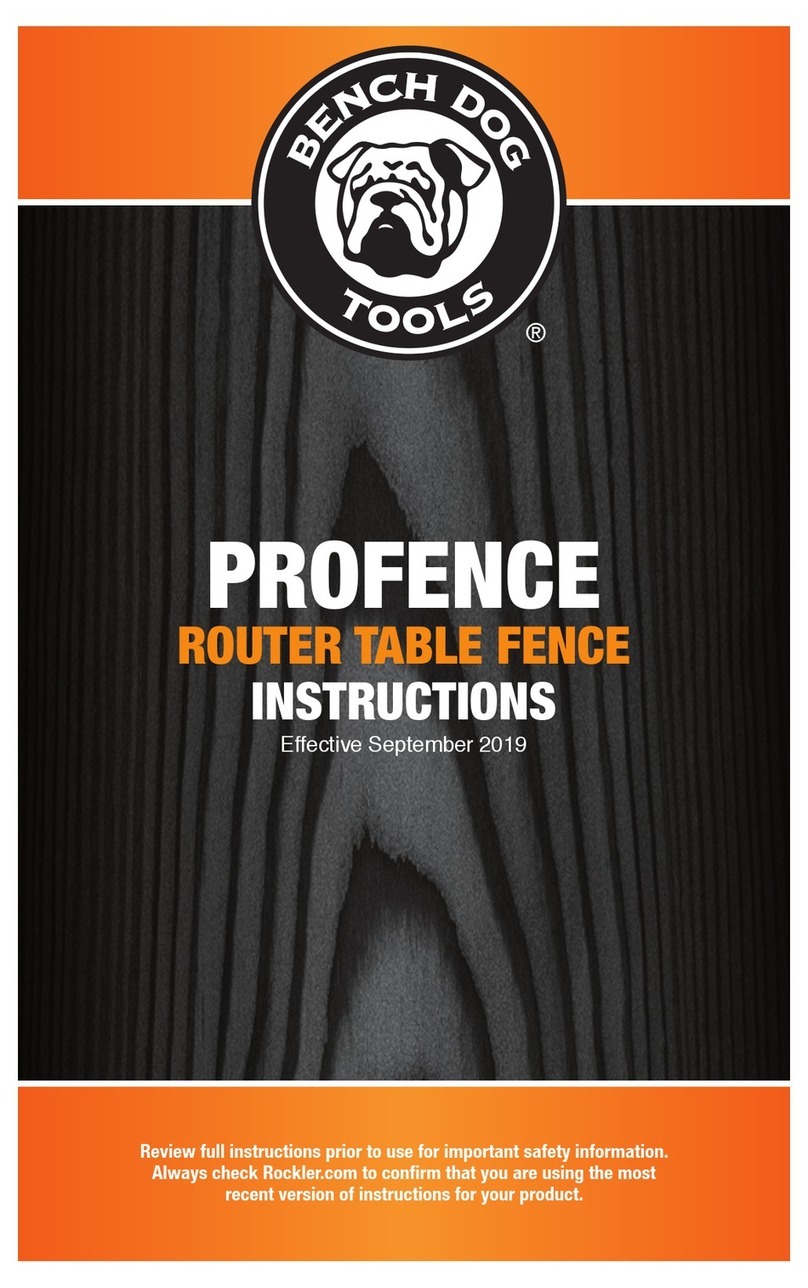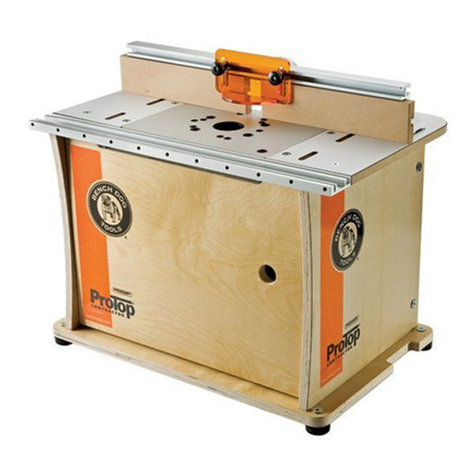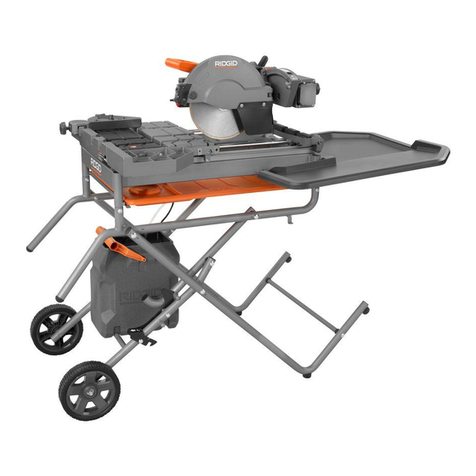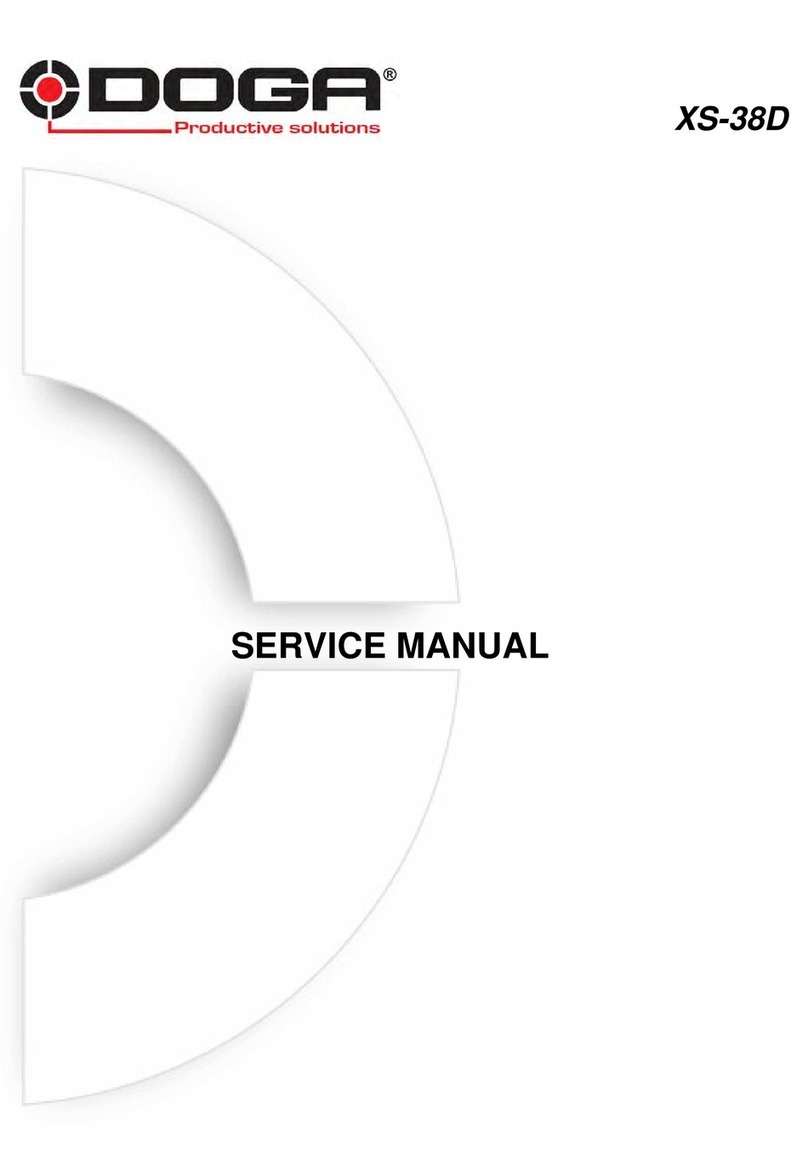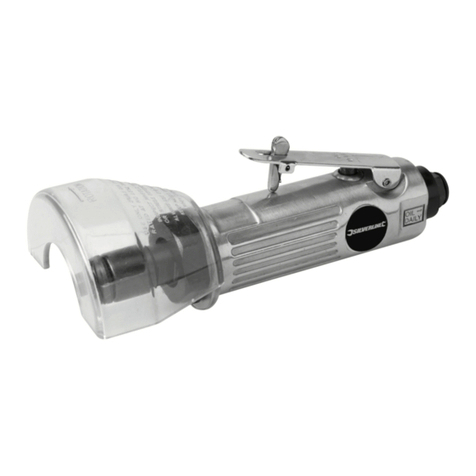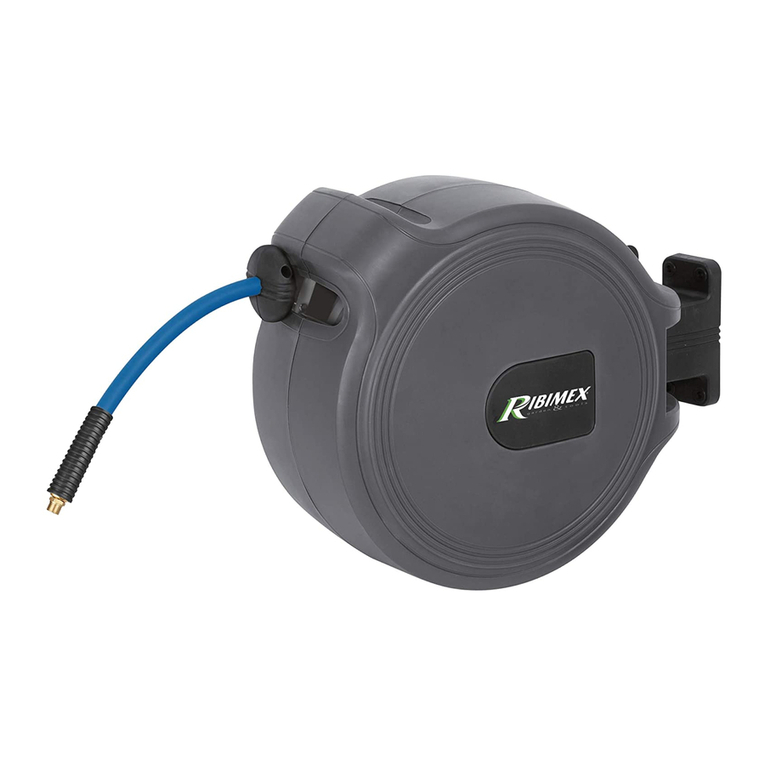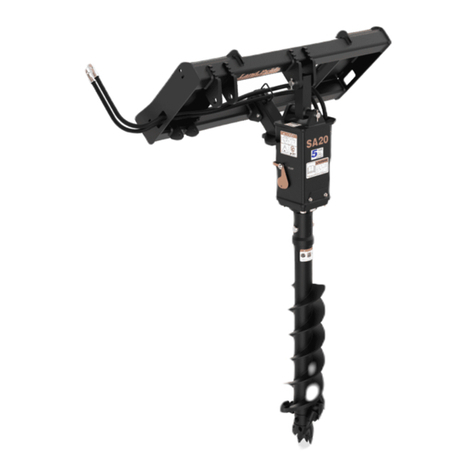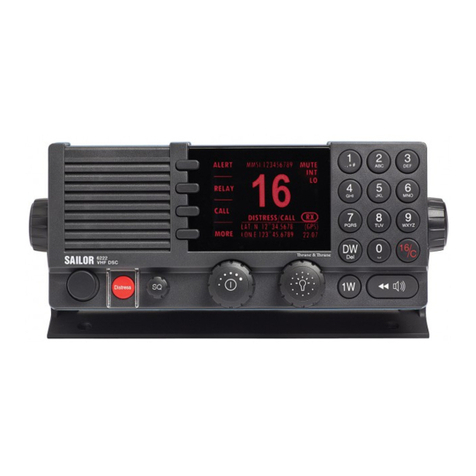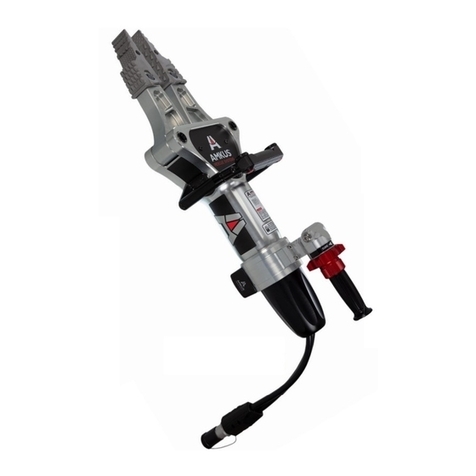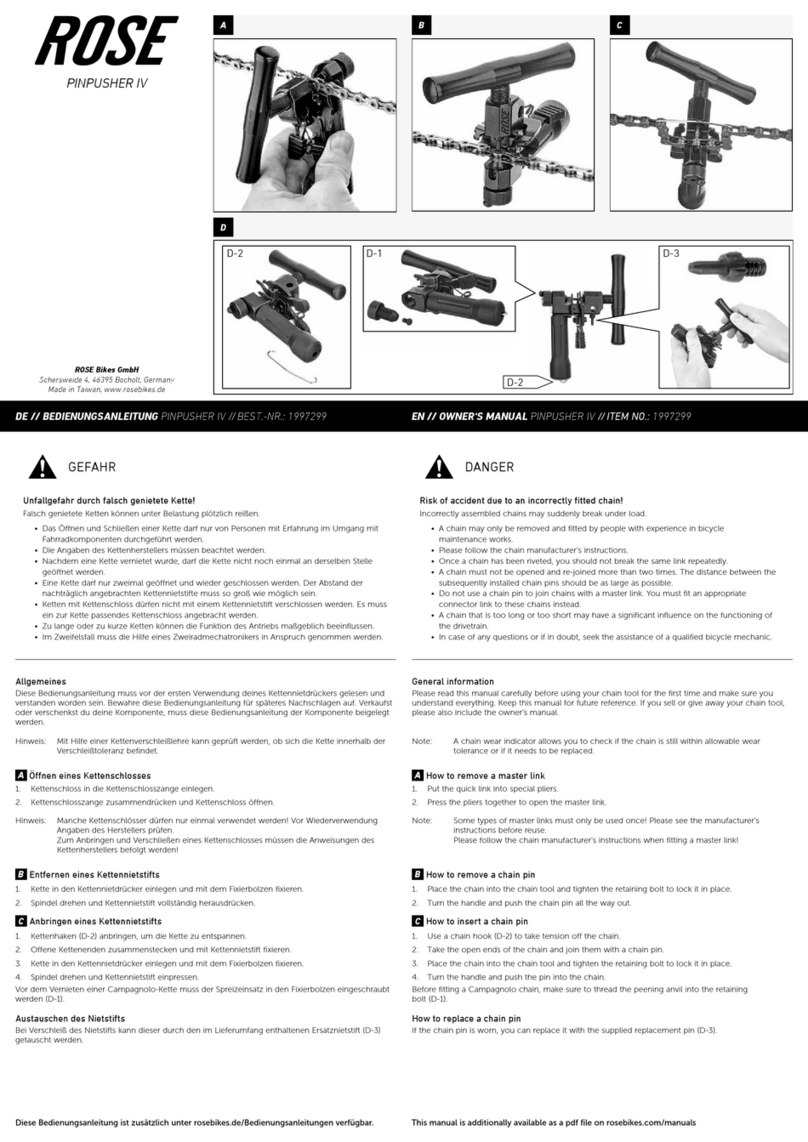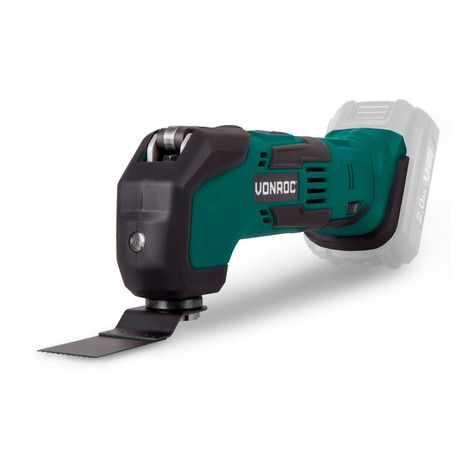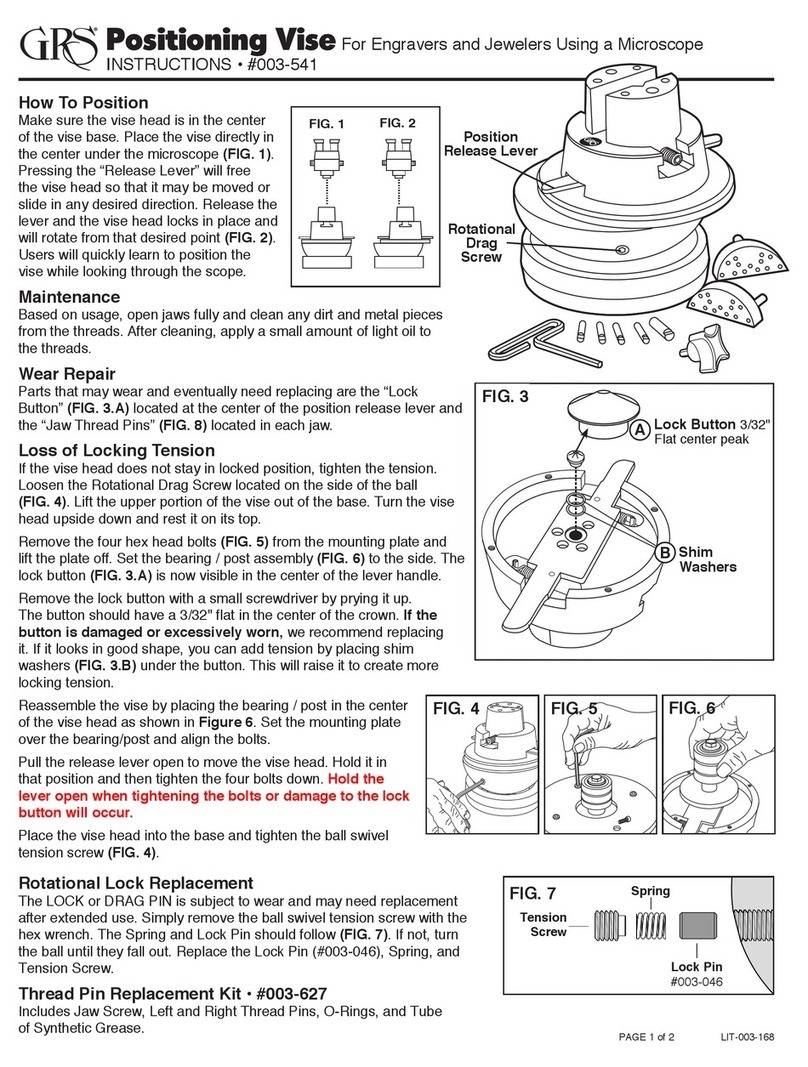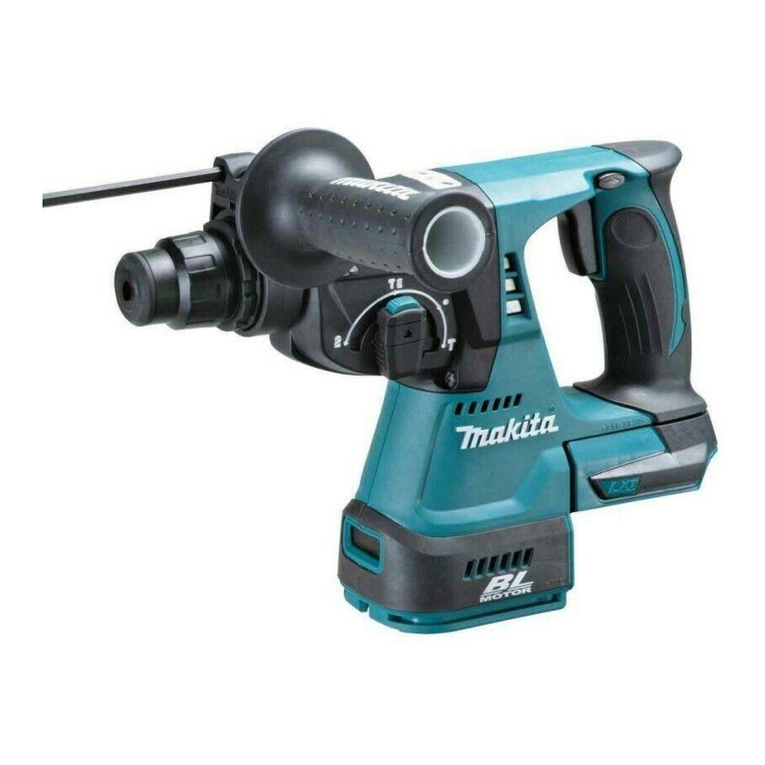Bench Dog Tools CROWN CUT User manual

Review full manual instructions prior to use for important safety information.
Always check Rockler.com to conrm that you are using the most
recent manual version for your product.
CROWN CUT
CROWN/COVE CUTTING JIG
INSTRUCTIONS
Effective October 2019


1
Index
General Safety Warnings. . . . . . . . . . . . . . . . . . . . . . . . . . . . . . . . . . . . . . . . . . . . . . . . . . . . . . . . . . . .2
Product Specific Warnings . . . . . . . . . . . . . . . . . . . . . . . . . . . . . . . . . . . . . . . . . . . . . . . . . . . . . . . . . .4
Importance of Measuring Accurately . . . . . . . . . . . . . . . . . . . . . . . . . . . . . . . . . . . . . . . . . . . . . . . . . .5
Types of Cuts . . . . . . . . . . . . . . . . . . . . . . . . . . . . . . . . . . . . . . . . . . . . . . . . . . . . . . . . . . . . . . . . . . . .5
Crown-Cut Setup . . . . . . . . . . . . . . . . . . . . . . . . . . . . . . . . . . . . . . . . . . . . . . . . . . . . . . . . . . . . . . . . .5
Making 90° Corner Cuts: Cutting Inside 90° Corners. . . . . . . . . . . . . . . . . . . . . . . . . . . . . . . . . . . . . .6
Making 90° Corner Cuts: Cutting Outside 90° Corners . . . . . . . . . . . . . . . . . . . . . . . . . . . . . . . . . . . .6
Making Splice or Scarf Joint Cuts: Cutting a Left-Over-Right Splice Joint . . . . . . . . . . . . . . . . . . . . .8
Making Splice or Scarf Joint Cuts: Cutting a Right-Over-Left Splice Joint . . . . . . . . . . . . . . . . . . . . .8

2BP0918
This product is designed only for specific applications as defined in the instructions and
should not be modified or used for any manner not described in these instructions. Use
only recommended accessories. Before using the Crown Cut Crown/Cove Cutting Jig: READ,
UNDERSTAND and FOLLOW ALL INSTRUCTIONS AND SAFETY WARNINGS. KEEP
THESE INSTRUCTIONS READILY AVAILABLE FOR FUTURE REFERENCE.
>Always confirm that you are using the most
recent version of the Instructions and safety
warnings for your product (see the
Instructions link on the product
page at Rockler.com).
>Before using another tool with this product,
always read, understand and follow the
instructions and safety warnings in the
owner’s manual for that tool. If you do not
have the owner’s manual, obtain one from
the tool’s manufacturer before using it with
this product.
>Before using any chemical with this
product, always read, understand and
follow all safety warnings and guidelines
in the manufacturer’s Safety Data
Sheet (SDS; formerly called “MSDS”),
especially regarding:
• How to safely use the chemical,
including potential hazards and
recommended first aid measures;
• Personal safety equipment required
to safely use the chemical (e.g. gloves,
eye protection, mask/respirator, etc.);
• Proper and safe handling, storage
and disposal of the chemical.
>Before using this product, review and verify
that all tools to be used with it have safety
equipment installed and are in proper
working order as defined by the tool’s
owner’s manual.
> Do not use this product until you have read
and are confident you understand:
• Product Specific Warnings (p. 4);
• Importance of Measuring
Accurately (p. 5);
• Types of Cuts (p. 5);
• Crown-Cut Setup (p. 5);
• Making 90° Corner Cuts (p. 6-7);
• Making Splice or Scarf Joint
Cuts (p. 8-9).
>The user assumes all risk and responsibility
for the proper and safe use of this product
and for ensuring product suitability for the
intended application.
>It is the sole responsibility of the purchaser
of this product to ensure that any anyone
you allow to use this product reads and
complies with all instructions and safety
precautions outlined in this manual
prior to use.
>Follow all standard shop safety
practices, including:
• Keep children and bystanders away
from the tool operating area;
• Do NOT use power tools in explosive
environments, or in the presence of
flammable liquids, fumes or dust;
• TURN OFF AND UNPLUG all power
tools BEFORE making any adjustments
or changing accessories;
• Remain alert and use good judgment.
Do not use this product if you are in any
way impaired by medications, alcohol,
drugs or fatigue;
• Keep your work area well lit and clean;
• Dress appropriately. Secure loose
clothing, remove all jewelry and tie
up long hair before using this product;
• ALWAYS wear safety glasses, hearing
protection and respiratory protection that
complies with ANSI safety standards;
• Use dust collection tools and dust face
masks to reduce exposure to dust;
• Use safety equipment such as
featherboards, push sticks and push
blocks, etc., when appropriate;
• Maintain proper footing at all times
and do not overreach;
• Do NOT force woodworking tools.
> These warnings and instructions Do
NOT represent the total of all information
available regarding tool safety, use and
technique. Always seek out opportunities
to learn more and improve your skills
and knowledge.
Drilling, sawing, sanding
or machining wood products can expose
you to wood dust, a substance known to
the State of California to cause cancer.
Avoid inhaling wood dust or use a dust
mask or other safeguards for personal
protection. For more information go to
www.P65Warnings.ca.gov/wood.
GENERAL SAFETY WARNINGS
2BP0918

3
Danger indicates a hazardous situation that, if not avoided, will result
in death or serious injury.
Warning indicates a hazardous situation that, if not avoided, could
result in death or serious injury.
Caution indicates a hazardous situation that, if not avoided, may result
in minor or moderate injury or property damage.
Notice indicates important or helpful information and/or user tips.
SAFETY WARNING KEY

24
>Keep hands and fingers out of the path of the saw blade.
Maintain awareness of the blade at all times.
>Never cut cross-handed.
>Always position the Crown-Cut on the
miter saw so that it is clear of the blade’s
cutting path by at least 1/2".
>Hold the Crown-Cut and molding securely
against the fence of the miter saw when
making cuts.
>Always allow the blade to come to a
complete stop before lifting the miter saw
handle and removing the Crown-Cut, the
molding and/or any offcut pieces.
> Do NOT attempt to cut pieces shorter
than 7".
> Always position moldings upside down on
the Crown-Cut. The jig will not produce
the desired results if the molding is not
positioned upside down.
>For best results, always provide adequate
support for long moldings.
> Always make tests cuts in scrap
molding to verify the fit of the joint
before cutting your final workpieces.
PRODUCT SPECIFIC SAFETY WARNINGS

5
Importance of Measuring Accurately
Most molding miscues involve incorrect
cuts or incorrect measurements. If set up
and used correctly, Crown-Cut eliminates
incorrect cuts. It’s up to you to avoid
incorrect measurements. Get help when
measuring long distances and double-check
your measurements whenever possible. As
the old woodworking adage goes: Measure
twice, cut once.
Types of Cuts
Crown-Cut is designed to make it easier to
get great results in four types of cuts with
crown or cove moldings: inside corners,
outside corners, left-over-right splice (or
scarf) joints and right-over-left splice (or
scarf) joints. The latter two cuts are used to
hide differences in moldings butted against
each other in long, straight runs.
Crown-Cut Setup
1. Place your molding (or a section of it)
upside down on the Crown-Cut.
2. From the back of the Crown-Cut,
loosen the screws holding the three
Fence Risers in Place and extend
the Fence Risers enough to support
the upper edge of the molding.
(Retract the Fence Risers when
not needed and for storage.) Fig. 1.
3. Loosen the knobs on the adjustable
Crown Stop and move it until both
flat sections on the back of the
molding are flush against the base
and fence of the Crown-Cut. Tighten
the knobs to lock in the final
position. Fig. 2.
Fig. 2
Fig. 1

26
Making 90° Corner Cuts
>Always position the Crown-Cut on the
miter saw so that it is clear of the
blade’s cutting path by at least 1/2".
>Hold the Crown-Cut and molding
securely against the fence of the
miter saw when making cuts.
>Always position moldings upside
down on the Crown-Cut. The jig will
not produce the desired results if the
molding is not positioned upside down.
>For best results, always provide
adequate support for long moldings.
>Always allow the blade to come to a
complete stop before lifting the miter
saw handle and removing the
Crown-Cut, the molding and/or any
offcut pieces.
> Do NOT attempt to cut pieces
shorter than 7".
> Always make tests cuts in scrap
molding to verify the fit of the joint
before cutting your final workpieces.
THESE WARNINGS PERTAIN TO ALL REMAINING STEPS:
>Keep hands and fingers out of the path of the saw
blade. Maintain awareness of the blade at all times.
>Never cut cross-handed.
Inside 90° Corners Outside 90° Corners

Fig. 5 - Outside 90° Corner Position A Fig. 6 - Outside 90° Corner Position A
Fig. 3 - Inside 90° Corner Position A Fig. 4 - Inside 90° Corner Position B
7
Cutting Inside 90° Corners
1. To cut the left-side molding, swing
the head of your miter saw 45° to the
right (adjust the angle if your walls aren’t
square) and position the Crown-Cut and
molding to the right of the blade. Fig. 3.
2. Make sure the Crown-Cut is tight
against the miter saw fence and at
least 1/2" clear of the blade’s path.
Also double-check that the molding
is upside down in the Crown-Cut.
3. Line up your mark and carefully
make the cut.
4. To cut the right-side molding, swing
the head of your miter saw 45° to the
left (adjust the angle if your walls aren’t
square) and position the Crown-Cut and
molding to the left of the blade. Fig. 4.
5. Make sure the Crown-Cut is tight
against the miter saw fence and at
least 1/2" clear of the blade’s path.
Also double-check that the molding
is upside down in the Crown-Cut.
6. Line up your mark and carefully
make the cut.
Cutting Outside 90° Corners
1. To cut the left-side molding, swing
the head of your miter saw 45° to the
left (adjust the angle if your walls aren’t
square) and position the Crown-Cut and
molding to the right of the blade. Fig. 5.
2. Make sure the Crown-Cut is tight
against the miter saw fence and at
least 1/2" clear of the blade’s path.
Also double-check that the molding
is upside down in the Crown-Cut.
3. Line up your mark and carefully
make the cut.
4. To cut the right-side molding, swing
the head of your miter saw 45° to the
right (adjust the angle if your walls aren’t
square) and position the Crown-Cut and
molding to the left of the blade. Fig. 6.
5. Make sure the Crown-Cut is tight
against the miter saw fence and at
least 1/2" clear of the blade’s path.
Also double-check that the molding
is upside down in the Crown-Cut.
6. Line up your mark and carefully
make the cut.

28
Making Splice or Scarf Joint Cuts
Cutting a Left-Over-Right Splice Joint
1. To cut the left-side molding, swing the
head of your miter saw 45° to the left
and position the Crown-Cut and molding
to the right of the blade. Fig. 7.
Right-Over-Left Splice
Left-Over-Right Splice
To decide whether
to use a left-over-right or a right-over-left
splice joint, note whether the joint will
be visible to the right or to the left when
you enter the room. If it will be visible
on the left, use the left-over-right cut.
If it will be visible to the right, use
the right-over-left cut.
>Always position the Crown-Cut on the
miter saw so that it is clear of the
blade’s cutting path by at least 1/2”.
>Hold the Crown-Cut and molding
securely against the fence of the
miter saw when making cuts.
>Always position moldings upside
down on the Crown-Cut. The jig will
not produce the desired results if the
molding is not positioned upside down.
>For best results, always provide
adequate support for long moldings.
>Always allow the blade to come to a
complete stop before lifting the miter
saw handle and removing the
Crown-Cut, the molding and/or any
offcut pieces.
> Do NOT attempt to cut pieces
shorter than 7”.
> Always make tests cuts in scrap
molding to verify the fit of the joint
before cutting your final workpieces.
THESE WARNINGS PERTAIN TO ALL REMAINING STEPS:
>Keep hands and fingers out of the path of the saw
blade. Maintain awareness of the blade at all times.
>Never cut cross-handed.

9
2. Make sure the Crown-Cut is tight
against the miter saw fence and at
least 1/2" clear of the blade’s path.
Also double-check that the molding
is upside down in the Crown-Cut.
3. Line up your mark and carefully make
the cut.
4. To cut the right-side molding, keep the
head of your miter saw at 45° to the left
and position the Crown-Cut and molding
to the left of the blade. Fig. 8.
5. Make sure the Crown-Cut is tight
against the miter saw fence and at
least 1/2" clear of the blade’s path.
Also double-check that the molding
is upside down in the Crown-Cut.
6. Line up your mark and carefully make
the cut.
Cutting a Right-Over-Left Splice Joint
1. To cut the left-side molding, swing the
head of your miter saw 45° to the right
and position the Crown-Cut and molding
to the right of the blade. Fig. 9.
2. Make sure the Crown-Cut is tight
against the miter saw fence and at
least 1/2" clear of the blade’s path.
Also double-check that the molding
is upside down in the Crown-Cut.
3. Line up your mark and carefully make
the cut.
4. To cut the right-side molding, keep the
head of your miter saw at 45° to the right
and position the Crown-Cut and molding
to the left of the blade. Fig. 10.
5. Make sure the Crown-Cut is tight
against the miter saw fence and at
least 1/2" clear of the blade’s path.
Also double-check that the molding
is upside down in the Crown-Cut.
6. Line up your mark and carefully make
the cut.
Check Rockler.com for updates. If you have further
questions, please contact our Technical Support
Department at 1-800-260-9663 or
support@rockler.com
Fig. 7 - Left-Over-Right Position A
Fig. 8 - Left-Over-Right Position B
Fig. 9 - Right-Over-Left Position A
Fig. 10 - Right-Over-Left Position B

Distributed by Rockler Companies, Inc.
Medina, MN 55340
23238
Rev 10/19
This manual suits for next models
1
Table of contents
Other Bench Dog Tools Tools manuals
